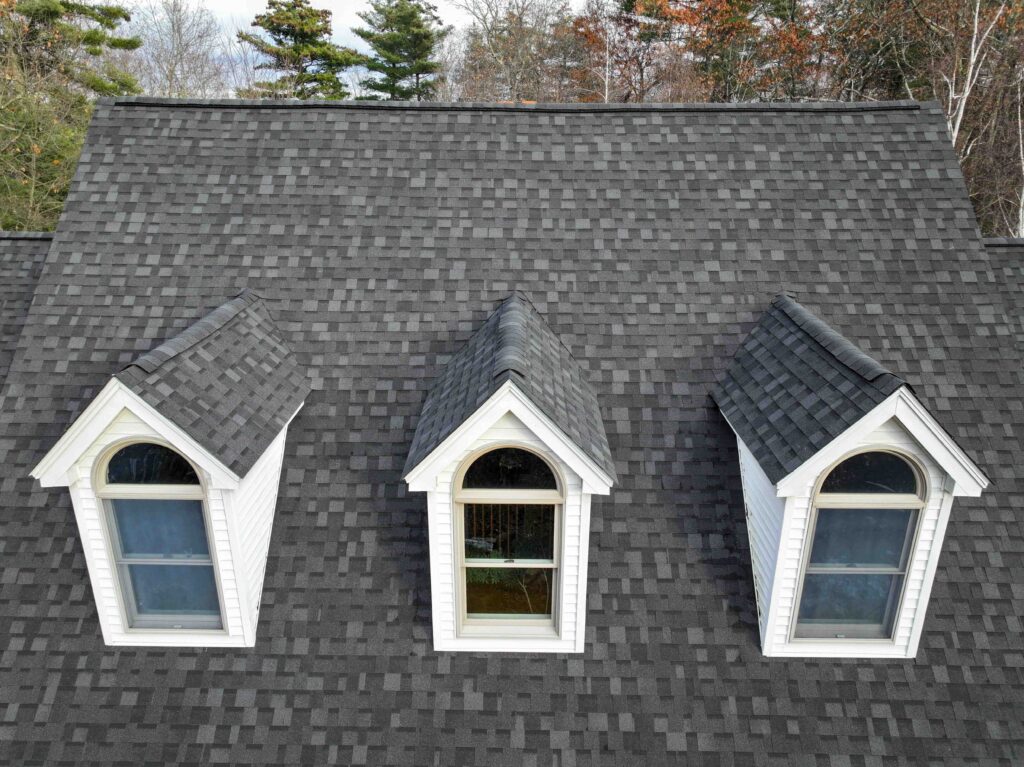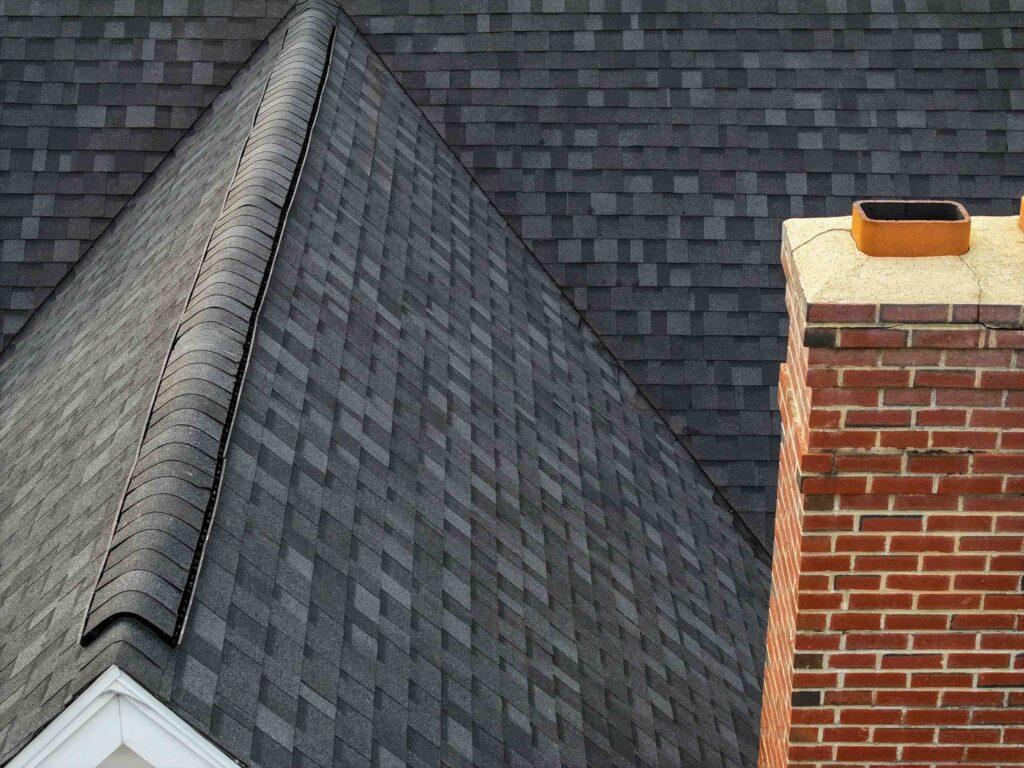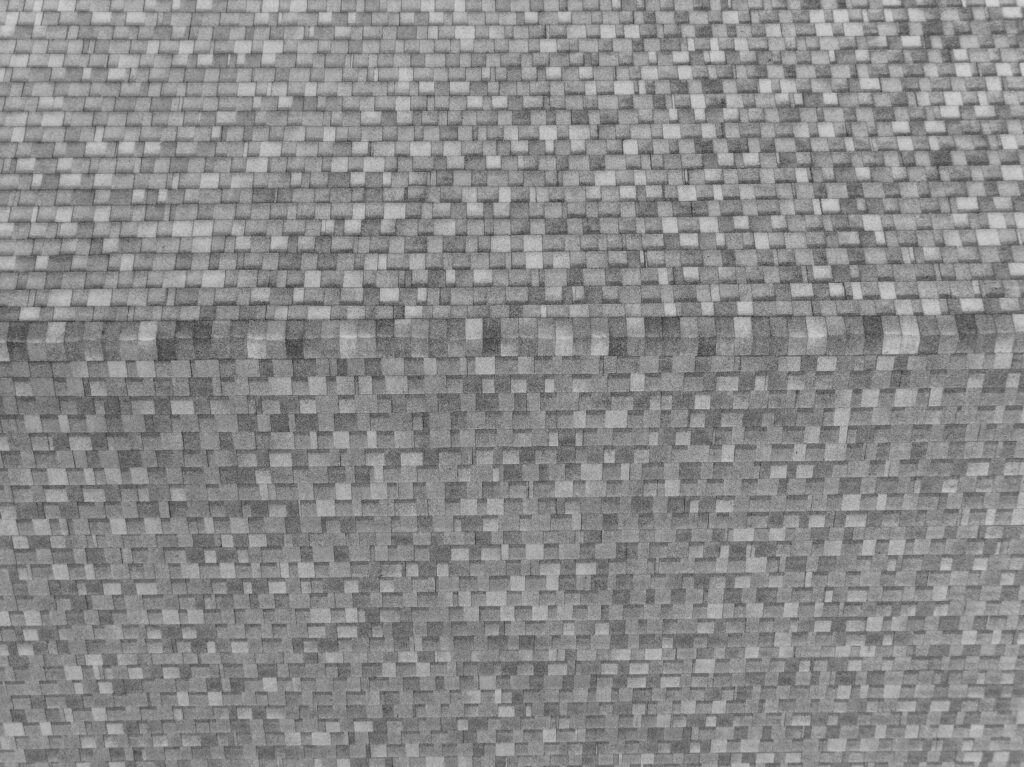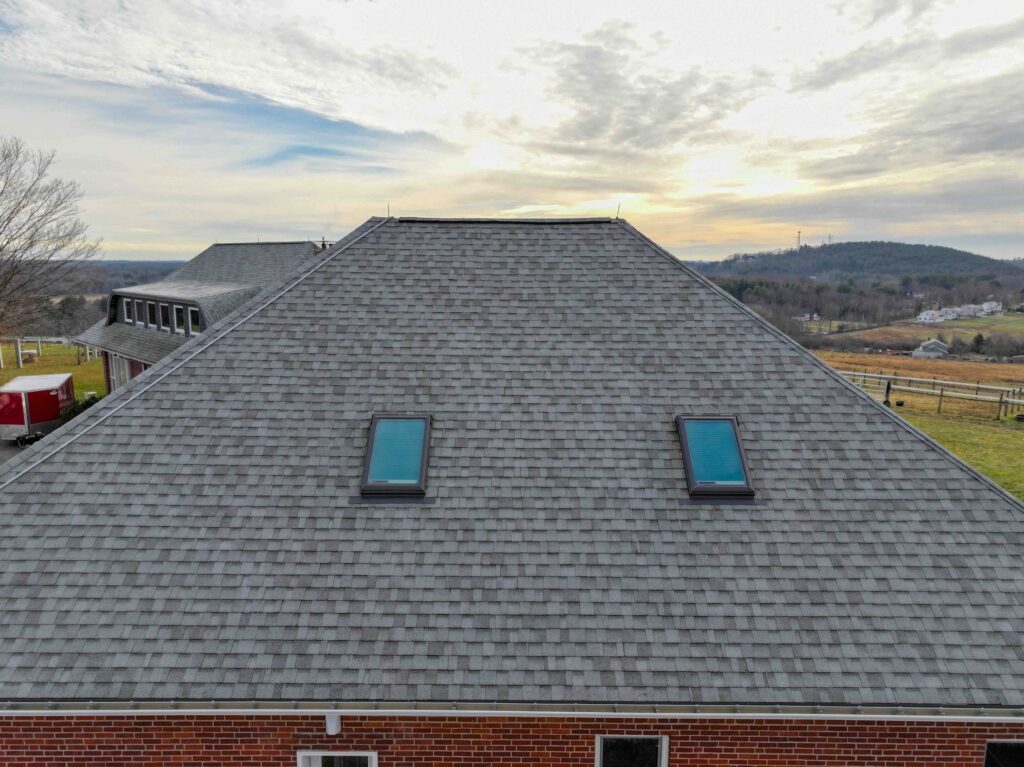The asphalt shingle roof is the most common type of roof installed across the U.S. today, mostly because it’s the most cost-effective for the average homeowner.
You may already have an asphalt shingle roof. If it’s time for a roof replacement, the question becomes: should you stick with the same thing or choose another type of roof?
In this guide, we’ll help you better understand what an asphalt roof is, how it’s different from a metal roof, and what its benefits are compared to other options. In learning more about this common roof type, you can decide whether it’s right for your home.
In this article:
- Is Asphalt the Same as Shingles?
- What Is an Asphalt Shingle?
- Components of Asphalt Shingles
- Types of Asphalt Shingles
- Features & Properties of Asphalt Shingles
- Erie Home Asphalt Shingle Roofs
- The Pros and Cons of Asphalt Shingle Roofs
- Asphalt Shingle vs. Metal Roofs
- Frequently Asked Questions
Is Asphalt the Same as Shingles?
A shingle is a thin, flat, rectangular piece of building material. A shingle is usually thicker at one end, allowing the roofers to layer the shingles and form overlapping rows. This, in turn, creates a waterproof barrier between your home and the elements, which is what keeps your home safe and protected.
Shingles are widely used for roof covering, but they are also sometimes used for siding. They are typically made of different materials, including wood, asphalt, clay, slate, and metal.
What Is an Asphalt Shingle?
An asphalt shingle is a specific type of roofing shingle that’s made of asphalt.

Asphalt is a building material used for constructing and maintaining roads, parking areas, railway tracks, airport runways, and more, as well as for making roofing shingles. Estimates indicate that about 87 percent of the asphalt in the U.S. is used for paving, while 11 percent is used for roofing.
Asphalt is made of several different materials, including the following:
- Aggregates: These raw materials include crushed rock, sand, gravel, or recycled materials. More recently, certain waste and by-products like construction and demolition debris are used as aggregates, which increases the sustainability of asphalt.
- Binder: A binder material holds all the raw materials together. Bitumen is most often used. It is a sticky, highly viscous liquid or semi-solid form of petroleum.
The asphalt used in roof shingles differs slightly from that used in paving. It is processed to a higher degree of toughness to resist the elements and protect a home for many years.
Components of Asphalt Shingles
An asphalt shingle has another component: a fiberglass mat. This forms the foundation upon which the asphalt and other materials are applied.
It’s made from glass fibers of a specific length and diameter that are bound together with resins and binders. During manufacturing, the fiberglass is wound into large rolls that are then unwound to create roofing shingles.

The part you see on the roof—the outer surface—is typically coated with stone granule surfacing. The granules can be processed into a variety of colors and sometimes have a reflective coating that can help reflect the sun’s heat.
A heat-activated asphalt sealant is spot-applied to the shingles to bond them together on the roof. It’s a sticky material designed to activate within a desired temperature range, and it helps to keep the roof sealed and resistant to wind and other roof stresses.
A “release film”—which looks like a shiny plastic tape about an inch or so wide—is often put on the back of the shingles to prevent them from sticking together during storage.
Types of Asphalt Shingles
Asphalt shingles can be grouped into the following three categories:
- 3-Tab Shingles: This is the oldest basic type of asphalt shingle. It has a single layer with cut-outs forming three individual tabs, which gives the roofing material a repetitive pattern. Each shingle looks like three different pieces on your roof. It’s the least expensive option.
- Dimensional Shingles: Also called an “architectural,” “laminated,” or “dragon tooth” shingle, this type is the most commonly used in home construction today. Created primarily for appearance, it has two layers of shingle material bonded together, which creates a three-dimensional appearance. It’s thicker than a 3-tab shingle, easier to install, and more durable.
- Premium/Designer Shingles: This type of shingle has a high-end aesthetic in either shape and/or color options. It’s similar to the dimensional shingle as it has two layers, but it has other features that create a premium look.
The premium shingle is made to mimic various styles, ranging from Victorian to old-world, from rugged to dramatic. It can look like a shake, tile, or slate shingle while costing less. It also delivers increased performance and impact resistance when compared to other types of shingles.
Features & Properties of Asphalt Shingles
In addition to the three categories of asphalt shingles mentioned above, other properties vary depending on the type of asphalt shingle roof you purchase.

Wind Resistance
Though all asphalt shingles are wind-resistant, some are more so than others. If you live in an area that regularly experiences high winds, ask about this property when evaluating your roofing options.
Asphalt shingles are tested to determine their wind resistance and can typically withstand wind speeds of up to 110 mph.
Impact Resistance
Do you get a lot of hard rain or hail in your area? If so, ask about impact resistance. Impacts can damage an asphalt roof, but some shingles are stronger than others.
Builders use the Underwriters Laboratory (UL) Standard 2218 when evaluating impact resistance. Asphalt shingles may be rated from 1 to 4, with 4 being the highest rating.
For example, Erie Home’s asphalt shingles carry a Class 3 impact resistance rating that allows them to easily withstand hailstones 1.75 inches in diameter.
It’s also worth asking your insurance company, as some provide premium discounts for Class 4-rated shingles.
Fire Resistance
Most asphalt shingles are fire resistant, which means the shingles are effective against exposure and provide a degree of fire protection to the roof.
Like impact resistance, Erie Home’s asphalt shingles carry this fire resistance, so you’ll also have the peace of mind of knowing your roof is protected against the elements.
Algae Resistance
Algae won’t hurt your asphalt shingles, but it doesn’t look very nice. Some asphalt shingles are treated to prevent algae growth, usually with a special copper composition in the granules. (Copper helps prevent algae growth.) If you live in a humid climate where algae may grow, you may want algae-resistant shingles.
Solar Reflection
When the sun beats down on your house, it can warm it up quickly. That means you’ll have to use your air conditioning or other cooling methods more often, increasing your energy costs. Solar-reflective shingles have special granules in them that reflect some of the sun’s energy. This helps keep temperatures inside the home cooler, reducing energy consumption.
If you live in a hot climate, you may want to check into this option. Some cities and states offer tax credits for solar-reflecting roofs.
Erie Home Asphalt Shingle Roofs
Erie Home offers the best in architectural (dimensional) asphalt roofing. Made of a heavy-weight fiberglass construction with a multi-layered coating, the shingles carry a Class 3 impact resistance rating, which means they can easily withstand hailstones with a 1.75-inch diameter.

They also feature a special granule surface blend that can reflect up to 25 percent of solar heat and UV rays, helping to reduce roof temperatures and energy costs. Backed by a patented fastening technology, they have a reliable strength against 130 mph winds. They also have algae-resistant protection to defend your roof in wet climates.
Erie Home offers a wide variety of shingle colors, including the traditional browns and reds, grays and tans, and even shades of blues and greens. Our asphalt roofs are backed by a limited lifetime warranty. Fill out this easy form for a free estimate now, or give us a call at 800-998-8301.
The Pros and Cons of Asphalt Shingle Roofs
With any choice you make for your home, you have to consider the pros and cons. Choosing what type of roof to install is no different. Below, we review the benefits and drawbacks of asphalt roofs.
Benefits of Asphalt Roofs
Affordable
Asphalt shingles are one of the most affordable options on the market today. Because asphalt itself is a low-cost material, the shingles are budget-friendly. Plus, installation is easy, which saves on labor costs.
The average cost of asphalt shingles will vary and depends on a number of factors, such as the type of material used and the manufacturer. You’ll also need to consider the cost of installation.
However, as with many home improvement projects, replacing your roof is an investment that adds value to your home.
Besides offering a wide variety of shingles, Erie Home can also provide financing options, allowing our customers to have both the roof they want and the peace of mind that comes with a professional installation.
Easy to Install
Asphalt shingles are the easiest of any roofing material to install. They can even be installed over your existing shingles, provided the roof deck is strong enough and there’s only one existing layer, saving you the cost of removing the old roof.
Long Life Span
Asphalt shingle roofs can last up to 30 years, depending on the type of shingle and the quality of the installation. Erie Home’s premium shingles come with a 30-year warranty that promises to repair or replace any failing product.
The heavier the shingle is, the longer it will last. Additional architectural or premium design elements can also increase lifespan.
Asphalt shingles stand up well against the elements and will keep your home safe, dry, and protected.
Variety of Styling Options
It used to be that most asphalt shingle roofs looked similar to one another, but that’s no longer the case. There are now a wide variety of options to choose from, including different colors, shapes, styles, and more.
Easy to Maintain
Regular roof maintenance can extend the life of your roof. For example, bad weather and harsh winds can sometimes damage your shingles. With an asphalt roof, you can remove the damaged ones and replace them, saving you the cost of replacing your entire roof.
Fire Resistance
Most styles of asphalt shingles that are treated with fire-resistant chemicals can help to reduce the spread of fire on the roof.
Sound Protection
You may not think about it when you’re inside your home, but asphalt shingle roofs help insulate sound. They offer protection from external noise, such as heavy rain.
Recyclable
In the past, asphalt shingles had to go straight to the landfill when they were removed. However, that’s changing today, as shingle waste can now be recycled. For example, recycled asphalt is often used to make and repair roads.
Potential Drawbacks of Asphalt Roofs
All building materials have both advantages and disadvantages. With asphalt roofs, the potential drawbacks include the following.
Vulnerable to Damage
When compared to metal roofs—which are growing in popularity—asphalt roofs are more vulnerable to damage from high winds. If you live near the coast or in other areas where high winds are a concern, you may have noticed how the wind can damage or even rip off asphalt shingles.
Extreme heat or frequent temperature fluctuations can also cause the shingles to expand and contract. Over time, this may result in cracks, disrupting the roof barrier.
May Develop Mildew
If you live in a humid climate and your roof is shaded or partially shaded, mildew may grow and spread on your asphalt shingles. This can be a difficult problem.
You can clean it off, which won’t hurt if you do it only occasionally. However, if you have to clean often, that could also damage your shingles or shorten the lifespan of your roof.
Not the Most Energy-Efficient Option
Though asphalt shingles—particularly those that reflect the sun’s rays—can help make your home more energy-efficient, they’re not considered the most energy-efficient option. If you’re looking for the most energy-efficient option, ask about metal roofing.
Installation Time is Limited
You can install a metal roof on your home at any time of year, and a winter installation can sometimes be the better option. However, some asphalt shingle roofs, need to be installed when the weather is warm enough to activate the sealant. Installing when it’s too cold can damage the shingles.
Fortunately, Erie Home offers professional installation all-year round, except in the harshest weather conditions. That means you can choose a time that’s convenient for you, even if it’s winter.
Not the Longest-Lasting
Though today’s asphalt shingles last longer than they used to, they’re still not the longest-lasting option. If you want a roof that will last 50 years, you’ll want to go with metal, which is the longest-lasting option.
Require Periodic Maintenance
Asphalt shingles are easy to install, but if you want to get the longest life out of them, you need to regularly inspect and repair them. It’s best to have your roofing company come out to do this.
They’ll look for damage to the shingles, as well as any moss and algae. They can then clean or repair the shingles as needed.
Environmental Impact
Manufacturers are working to make asphalt shingles more environmentally friendly, but right now, they are not the greenest option. If you want the most sustainable roof, consider clay tile, wood, or metal.
Asphalt Shingle vs. Metal Roofs
We mentioned some of the ways that asphalt shingle roofs differ from other types of roofs, but here we give you a more succinct comparison between asphalt and metal roofs.
| Asphalt Shingle Roof | Metal Roof |
| Lasts up to 30 years, depending on the material | The longest-lasting type of roof: 50 years |
| More affordable, depending on the style and material | More expensive than asphalt, but adds greater value to your home |
| Requires regular inspection and maintenance | Typically requires less maintenance, though standing -seam metal roofs can be more difficult to patch-repair. |
| Durable but can be damaged by wind and may develop algae and moss | More durable and can withstand extreme weather like high winds, fire, and hail |
| Easy to install | Weighs less than asphalt shingles, but requires expert installation |
| Tend to be warmer, costing more in the summer months and warmer climates | Cooler in warm climates, as the metal reflects the sunlight |
| Warmer in the winter, saving heating costs | Can be cooler in the winter |
| Can accumulate snow | Easily sheds snow |
| Resale is slightly less | Resale is higher, with a metal roof replacement retaining about 50% of the job cost at resale |
| Less sustainable, though that is changing | Metal roofing materials are mostly recycled |
Erie Home offers both metal and asphalt shingle roofs. We also offer a free inspection and can even produce a 3D representation of your home with different roofing styles so you can evaluate the options and choose the best option for your home. Call us at 1-800-998-8301 or contact us today to get started.
Frequently Asked Questions
Are asphalt shingles waterproof?
Yes, asphalt shingles are waterproof. The asphalt mixed with minerals makes them waterproof, as well as the way they are installed.
Are asphalt shingles the same as composite shingles?
Contractors often use both terms interchangeably when talking about asphalt shingles, but the two terms do describe different types of shingles. Asphalt roofing has a durable protective layer of asphalt added for extra protection from the elements.
Composite shingles—also called synthetic shingles—are made of a synthetic polymer or recycled materials, then they’re made to look like slate or cedar shake roofs.
What is the best type of shingles for roofing?
Asphalt shingles are the most commonly used shingles, but within that category are three different types: 3-tab, dimensional, and luxury. These differ in how they’re manufactured and how they look once they’re installed.
Luxury shingles typically last longer than basic 3-tab shingles. Dimensional shingles offer a three-dimensional look and are the most popular type of asphalt shingles used today.
What is the cheapest type of roof shingle?
Asphalt is the most economical type of roof shingle overall. Within that category, 3-tab shingles are the cheapest.
Which is better—a metal roof or asphalt roof?
It depends on your priorities. If you want the most durable roof that will last as long as possible and you have more money to spend, choose a metal roof. If you are looking for a cost-effective option that is still long-lasting and durable, choose an asphalt shingle roof.
